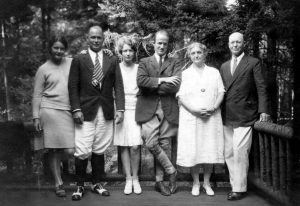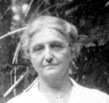(7 November 1876 – ca. 24 August 1956)
The University of North Carolina at Chapel Hill Herbarium (NCU) has cataloged 25 specimens collected by Mary Cloyd Burnley Stifler, who went by “Cloyd” and used “C. B. Stifler” on most labels. As cataloging of our collections continues, perhaps more will be found. NCU’s fungal specimens collected by Stifler were collected 1930’s and 1940’s from various locations around Bradenton, Manatee County, Florida, from Lake Geneva, Walworth County, Wisconsin, and from Indiana Dunes National Lakeshore. She sent many to Dr. William Chambers Coker and Alma Holland Beers at the University of North Carolina at Chapel Hill for identification or for confirmation of her identifications.

In 1938 Ms. Stifler collected fungi at “Wychwood, Lake Geneva, Wisconsin”. “Built in 1902, [Wychwood] was named for the wych-hazel plants that populated the grounds. From its inception, Mr. and Mrs. Charles Hutchinson envisioned Wychwood as a sanctuary for wild flowers and wild life, and every part of the home and its property was designed with that purpose in mind. Hutchinson made his wealth as president of the Corn Exchange Bank. He was active in philanthropic activities, both in Chicago and the town of Lake Geneva. He conceived the idea of a building that still stands on Broad Street in Lake Geneva called Horticultural Hall where gardeners from the lakeshore and local farmers would bring their produce and flowers to market. He also helped to form the Lake Geneva Garden Club, among other similar organizations.The couple willed the property to the University of Chicago in 1932 for use in the study of wild flowers and wild life, including the development of new strains of plants. Before the University sold the property, it made the estate available for tours and education for local school children. In 1957 a banker by the name of Charles Mitchell purchased the estate… [and later] William Wrigley (of chewing gum fame) purchased the property, which adjoined his own Green Gables estate. It remains in the Wrigley family today.”10
Ms. Stifler also collected vascular plants (particularly pteridophytes), bryophytes, lichens and algae, and her collections are curated across North America.
Herbaria curating specimens collected by Mary Cloyd Burnley Stifler 8
Herbarium acronym: Institution: organism group
NCU: University of North Carolina at Chapel Hill: fungi
ASU: Arizona State University: lichens
BING: State University of New York at Binghamton: bryophytes
BPI: United States Department of Agriculture: fungi
CUP: Cornell University: fungi
DUKE: bryophytes
F: Field Museum: fungi, bryophytes, algae
FLAS: University of Florida: fungi, pteridophytes, bryophytes, lichens
ISC: Iowa State University: fungi, bryophytes
MICH: University of Michigan: fungi
MO: Missouri Botanical Garden: pteridophytes, bryophytes
MSC: Michigan State University: pteridophytes
MU: Miami University: fungi
NY: New York Botanical Garden: fungi, pteridophytes, bryophytes
OS: Ohio State University: bryophytes
OSC: Oregon State University: fungi
PH: Academy of Natural Sciences at Drexel University: pteridophytes
PUR: Purdue University: fungi
TAES: Texas A&M: pteridophytes
TENN: University of Tennessee, Knoxville: fungi, bryophytes
UC: University of California, Berkeley: fungi, lichens, algae
US: United States National Museum of Natural History: pteridophytes
WIS: University of Wisconsin, Madison: bryophytes, lichens
According to the Women’s Who’s Who In America (1914 ), Cloyd Burnley Stifler was born in Williamsport, Pennsylvania, on 7 November, 1876, the daughter of Sallie H. Updegraff Burnley and Charles W. Burnley, a clergyman.1,9 She attended Williamsport Dickinson Seminary then earned her Bachelor of Arts from Goucher College (Maryland) in 1897.4 She earned a Masters degree (A.M.) from Women’s College of Baltimore in 1899.3 She was a fellow in chemistry at Bryn Mawr College in Pennsylvania (1897-1898), an instructor in chemistry at Vassar College in New York (1898-1908), and a research fellow in chemistry at Bryn Mawr College (1908-1909).1
 Randell Jesup writes, “Mary Cloyd Burnley Stifler was my step-great-grandmother *and* my great-great-aunt. James Madison Stifler, II married Lucy Hannah Burnley, who died shortly after my grandfather, Francis Stifler, was born. [On 28 July 1909] James Madison Stifler, II then married Lucy’s sister, Cloyd Burnley, and they had two more children, Lucy (29 May 1911- 1945) and Cloyd.”
Randell Jesup writes, “Mary Cloyd Burnley Stifler was my step-great-grandmother *and* my great-great-aunt. James Madison Stifler, II married Lucy Hannah Burnley, who died shortly after my grandfather, Francis Stifler, was born. [On 28 July 1909] James Madison Stifler, II then married Lucy’s sister, Cloyd Burnley, and they had two more children, Lucy (29 May 1911- 1945) and Cloyd.”

L to R: Cloyd Stifler, James Madison Stifler III, Lucy Stifler, Francis Stifler, Mary Cloyd Burnley Stifler, James Madison Stifler II
photograph courtesy of Randell Jesup
Cloyd Burnley Stifler was active in the Woman’s Baptist Foreign Missionary Society of the West1, but how and when she became interested in botany is unclear.
By 1914, Cloyd, James and children had moved to 1029 Grove Street in Evanston, Illinois, when James had become the Pastor of First Baptist Church in that city.5,11 Cloyd Stifler’s 1937 and 1941 papers on fungi list her affiliation as “Chicago, Ill.” (1937) and “Department of Botany, University of Chicago, Chicago, Illinois” (1941). Cloyd’s spouse, Rev. James Stifler, was a member of the Board of Trustees of the University of Chicago, and served as chair of the development committee from 1931-1934, and as secretary of the University from 1934-1940.12 In April, 1942 there is a marriage notice of Miss Cloyd Stifler, “daughter of the Rev. and Mrs. James Madison Stifler of Wilmette” to John Bockover Johnson, Jr.6
By 1943 it seems that Ms. Stifler had moved to Florida — or at least spent many months of the year there — as most of her specimens at NCU from that year onward are from Manatee County, Florida.
“Mrs. Mary Cloyd Stifler was found dead yesterday at her residence after a neighbor had complained to police she had not heard from nor seen Mrs. Stifler for several days. Mrs. Stifler was pronounced dead of natural causes by [Manatee] County Coroner Frank Schaub. Mrs. Stifler, 315 16th Street West [Bradenton, Florida], was the widow of Rev. James Madison Stifler, who died here in April 1949. The Stiflers came here in 1942 from Evanston, Ill. [Illinois]. Mrs. Stifler taught chemistry at Vassar, and received two chemistry fellowships to Bryn Mawr. She later studied at the University of Chicago. She was a charter member of the Manatee Business and Professional Women’s Club, a past president of the Manatee County Audubon Society, and was a member of the Manatee River Garden Club and of Hibiscus Circle. She is survived by two step-children, Mrs. John B. Johnson, Jr., Milwaukee; and Francis M. Stifler, Devon, Pa.”2
PUBLICATIONS:
Stifler, Cloyd Burnley (1950) The use of the microscope in the study of mosses. Micro-Notes V (1): 22-28.
Stifler, Cloyd Burnley (1949) Myxomycetes, Mycetozoa, or Slime Molds . Micro-Notes IV (3): 52-65.
Stifler, Cloyd Burnley (1941) A new genus of Hypocreales. Mycologia 33(1): 82-86.
Stifler, Cloyd Burnley (1937) A new species of Tuberaceae for America. Mycologia 29(3): 325-326.
Kohler, E. P. and M. Cloyd Burnley (1910) Reaction between unsaturated compounds and organic magnesium compounds. XIII. Derivatives of cyclohexane. American Chemical Journal 43(5): 412-417.
Kohler, E. P., G. L. Heritage, M. C. Burnley (1910) The Friedel and Crafts reaction with chlorides of unsaturated acids. American Chemical Journal 44(1): 60-75.
SOURCES:
1. Leonard, John William (editor) (1914) Woman’s Who’s Who of America: A Biographical Dictionary of Contemporary Women of the United States and Canada. New York: The American Commonwealth Company. Page 784.
2. “Mrs. Stifler Dies; Widow of Minister” St. Petersburg Times. Friday, 24 August 1956.
3. Annual Program of the Woman’s College of Baltimore. 1901. Baltimore: The Lord Baltimore Press. Page 17.
4. Ninth Annual Program of the Woman’s College of Baltimore, 1897. 1896. Baltimore: The Friedenwald Co. Page 16.
5. Bryn Mawr College Calendar Register of Alumnae and Former Students. 1914. Bryn Mawr College, Bryn Mawr, Pennsylvania. Volume VII, Part 1: 58.
6. Johnson-Stifler Wedding Rites Held in Suburb. Chicago Tribune April 20, 1942, page 18.
7. Pers. comm., email Randell Jesup to McCormick, 8 April 2018.
8. Information obtained by searching mycoportal.org , pteridoportal.org , bryophyteportal.org , lichenportal.org , sernecportal.org , macroalgae.org , and mycoportal.org on 22 October 2020.
9. Historical Society of Pennsylvania; Philadelphia, Pennsylvania; Historic Pennsylvania Church and Town Records; Reel: 318. Methodist Church Records. Valley Forge, Pennsylvania: Eastern Pennsylvania United Methodist Church Commission on Archives and History. Ancestry.com. Pennsylvania and New Jersey, Church and Town Records, 1669-2013 [database on-line]. Lehi, UT, USA: Ancestry.com Operations, Inc., 2011. accessed on 22 October 2020.
10. Meyers, Pamela S. 2015. Wychwood — Another unique estate from days gone by on Geneva Lake. Heroes, Heroines, and History. https://www.hhhistory.com/2015/12/wychwood-another-unique-estate-from.html accessed on 23 October 2020
11. “Rev. James Madison (J.M.) Stifler” Baptist History Homepage. http://baptisthistoryhomepage.com/stifler.james.madison.html accessed on 23 October 2020. (this page lists https://www.library.illinois.edu/ihx/inventories/blair-leverett-stifler_family-guide.pdf as the source for its information)
12. “James Madison Stifler” Prabook. https://prabook.com/web/james_madison.stifler/280375 accessed on 23 October 2020.
